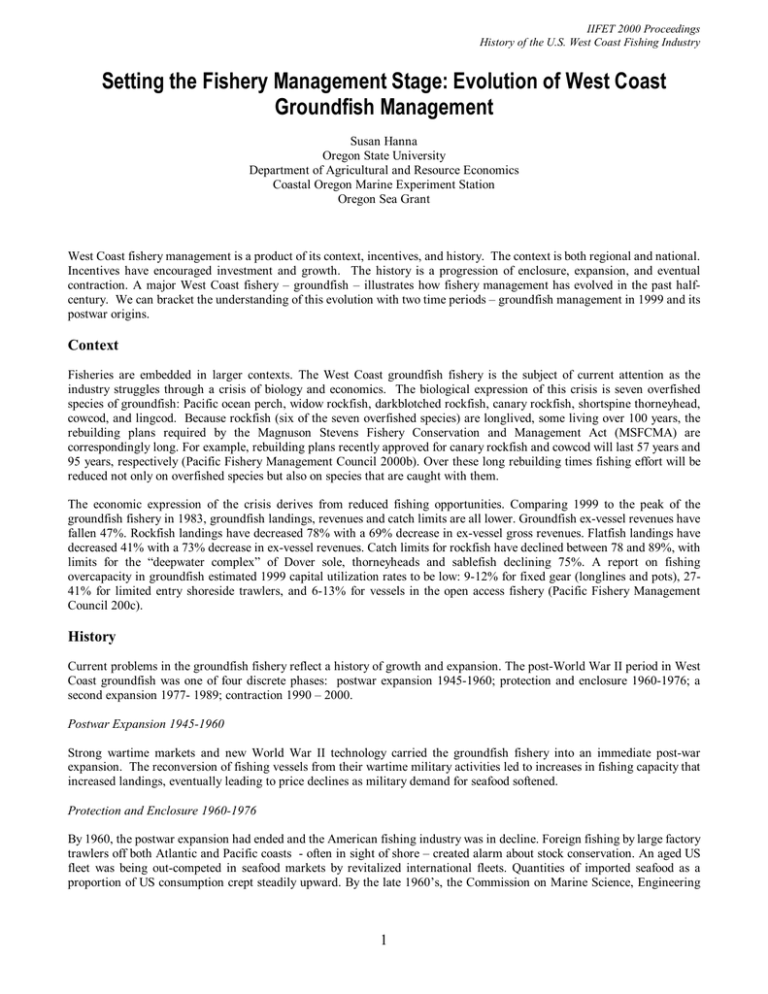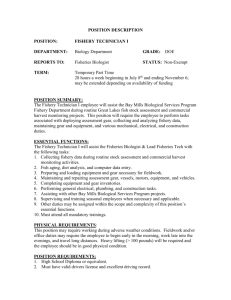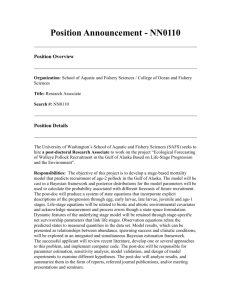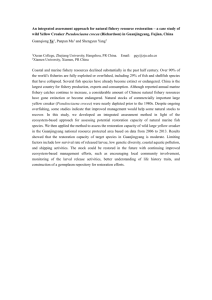Setting the Fishery Management Stage: Evolution of West Coast Groundfish Management
advertisement

IIFET 2000 Proceedings History of the U.S. West Coast Fishing Industry Setting the Fishery Management Stage: Evolution of West Coast Groundfish Management Susan Hanna Oregon State University Department of Agricultural and Resource Economics Coastal Oregon Marine Experiment Station Oregon Sea Grant West Coast fishery management is a product of its context, incentives, and history. The context is both regional and national. Incentives have encouraged investment and growth. The history is a progression of enclosure, expansion, and eventual contraction. A major West Coast fishery – groundfish – illustrates how fishery management has evolved in the past halfcentury. We can bracket the understanding of this evolution with two time periods – groundfish management in 1999 and its postwar origins. Context Fisheries are embedded in larger contexts. The West Coast groundfish fishery is the subject of current attention as the industry struggles through a crisis of biology and economics. The biological expression of this crisis is seven overfished species of groundfish: Pacific ocean perch, widow rockfish, darkblotched rockfish, canary rockfish, shortspine thorneyhead, cowcod, and lingcod. Because rockfish (six of the seven overfished species) are longlived, some living over 100 years, the rebuilding plans required by the Magnuson Stevens Fishery Conservation and Management Act (MSFCMA) are correspondingly long. For example, rebuilding plans recently approved for canary rockfish and cowcod will last 57 years and 95 years, respectively (Pacific Fishery Management Council 2000b). Over these long rebuilding times fishing effort will be reduced not only on overfished species but also on species that are caught with them. The economic expression of the crisis derives from reduced fishing opportunities. Comparing 1999 to the peak of the groundfish fishery in 1983, groundfish landings, revenues and catch limits are all lower. Groundfish ex-vessel revenues have fallen 47%. Rockfish landings have decreased 78% with a 69% decrease in ex-vessel gross revenues. Flatfish landings have decreased 41% with a 73% decrease in ex-vessel revenues. Catch limits for rockfish have declined between 78 and 89%, with limits for the “deepwater complex” of Dover sole, thorneyheads and sablefish declining 75%. A report on fishing overcapacity in groundfish estimated 1999 capital utilization rates to be low: 9-12% for fixed gear (longlines and pots), 2741% for limited entry shoreside trawlers, and 6-13% for vessels in the open access fishery (Pacific Fishery Management Council 200c). History Current problems in the groundfish fishery reflect a history of growth and expansion. The post-World War II period in West Coast groundfish was one of four discrete phases: postwar expansion 1945-1960; protection and enclosure 1960-1976; a second expansion 1977- 1989; contraction 1990 – 2000. Postwar Expansion 1945-1960 Strong wartime markets and new World War II technology carried the groundfish fishery into an immediate post-war expansion. The reconversion of fishing vessels from their wartime military activities led to increases in fishing capacity that increased landings, eventually leading to price declines as military demand for seafood softened. Protection and Enclosure 1960-1976 By 1960, the postwar expansion had ended and the American fishing industry was in decline. Foreign fishing by large factory trawlers off both Atlantic and Pacific coasts - often in sight of shore – created alarm about stock conservation. An aged US fleet was being out-competed in seafood markets by revitalized international fleets. Quantities of imported seafood as a proportion of US consumption crept steadily upward. By the late 1960’s, the Commission on Marine Science, Engineering 1 IIFET 2000 Proceedings History of the U.S. West Coast Fishing Industry and Resources (the “Stratton Commission”), issued a report on US policy for living marine resources that emphasized the national interest in fishery rehabilitation, development and expansion to create wealth (Commission on Marine Science, Engineering and Resources 1969). The 1973 Congressional “Eastland Resolution” committed the federal government to providing “all support necessary” to strengthen the US fishing industry (Heinz Center 2000). This was followed in 1976 by the passage of the Fishery Conservation and Management Act (FCMA), which extended US jurisdiction over fisheries to 200 miles offshore and established the system of eight regional fishery management councils under which fisheries are still managed today. Expansion II 1977-1989 Under the FCMA, renamed the Magnuson Fishery Conservation and Management Act (MFCMA) in 1980, West Coast groundfish fisheries expanded along with other US fisheries,. Under the assurance of management preference for American fishermen and processors, and with the aid of capital construction funds and loan guarantees, new fishing and processing capacity entered the fishery. Limitations on fishing effort were minimal, with emphasis on gear restrictions and controls on total harvest. Contraction 1989-2000 Groundfish landings peaked in the early 1980s, and by 1989 it was clear that current levels of groundfish fishing capacity could not be maintained. Groundfish stocks, relatively unexploited in 1977, by now had been fished down from virgin levels. Quotas set to stabilize the catch at MSY became progressively more restrictive under new research information that revised stock sizes downward. The new mandates of the MSFCMA applied stricter controls on fishing mortality. Access limitations were implemented through a tradable permit program designed to lead reduced fishing capacity over time. External changes were also in effect. A broader set of voices claimed an interest in the performance of fishery management. Management was now answering not only to commercial and recreational fishermen, but also to environmental organizations and the public who insisted on more sustainable management practices. Incentives One of the great lessons of West Coast groundfish management’s fifty-year postwar history is that people respond to incentives. The growth in postwar fisheries that led to present problems was intentional, driven by incentives provided to ensure the expansion. The view of fisheries problems 30 years ago was quite different from that of today. A quote from Senator Warren Magnuson, principle sponsor of the FCMA, illustrates the difference in sentiment. Addressing a conference of state and federal fishery managers in 1968, Magnuson exhorted them: You have no time to form study committees. You have no time for biologically researching the animal. …Your time must be devoted to determining how we can get out and catch fish. Every activity…whether by the federal or state governments, should be primarily programmed to that goal. Let us not study our resources to death, let us harvest them… (Magnuson 1968) The path that groundfish management followed was shaped by growth incentives. The absence of entry limits led to a competitive race for fish that rewarded investment in fishing capital. The net result was an over-investment in fishing capital that created a fleet capacity too great for either resource sustainability or economic efficiency. In contrast, groundfish management was under-investing in management capacity – the body of skills and knowledge required to maintain management that can adapt to changing conditions in the fishery. As fishing effort became more complex and difficult to control, managers developed complicated rules that required more personnel and fiscal resources and shortened the management planning horizon. The 1996 passage of the Sustainable Fisheries Act amending the MFCMA sent a powerful signal of change to fishery management. The amendments required that overfishing be eliminated. Rebuilding plans must be developed and implemented for all overfished stocks. Bycatch must be minimized to the extent practicable. Essential fish habitat must be documented and protected from the harmful effects of fishing. The impacts of fishery regulations on the sustainability of fishing communities must be assessed and considered when making management decisions National Marine Fisheries Service 1996). The changes outlined by these amendments made the old incentives, so successful for fishery growth and expansion, obsolete. New incentives are needed to help groundfish management make the transition to new goals and objectives. 2 IIFET 2000 Proceedings History of the U.S. West Coast Fishing Industry The Transition The transition facing West Coast groundfish is affecting other fisheries and natural resources. Public attitudes about resources are in flux, with values for nonconsumptive use and nonuse being added to the mix. As population grows, competition for all resources is intensifying, resource scarcity is increasing and tradeoffs between alternative uses are becoming more starkly defined. A broader set of constituents is claiming interest in the performance of resource management. Management is being shaped by uniform standards imposed through national laws and international agreements. The transition for fishery management in general, and groundfish management in particular, is haunted by many uncertainties. Rudimentary ecological knowledge makes management at the ecosystem scale difficult. Public values and expectations for fishery management are diverse and sometimes unclear. Lack of information about many new management tools make their consideration extremely controversial. The application of electronic technology to monitor fishing behavior is similarly controversial. People have different ideas about the appropriate distribution of authority and rights over publicly owned fishery resources. Despite the pressures of the current groundfish crisis, West Coast groundfish management is relatively well placed to make the transition. Several attributes of West Coast fishery management will hold it in good stead as it moves toward a future that is significantly different from the past. Because Pacific groundfish were relatively lightly fished at the point of FCMA implementation, the Pacific Fishery Management Council had time to develop a history of strong participatory management based on interstate coordination, state-federal cooperation, strong industry participation and a philosophical acceptance of management. The industry has taken a strong leadership position in research participation, advice and decisionmaking. The scientific information base is improving. The Pacific Fishery Management Council has adopted a long-term strategic plan to guide the future of groundfish management (Pacific Fishery Management Council 2000a). Despite these advantages, many roadblocks stand in the way of the transition. All management decisions have distributional effects because resources are fully utilized and the fleet is overcapitalized. Each action creates winners and losers who are pitted against each other instead of working toward a common objective. The history of resource surplus in the groundfish fishery leaves some managers with the expectation that, if they only look hard enough, they can find management actions that have no negative impacts on user groups. Fishery management plans contain long lists of competing and often unquantifiable objectives that make it impossible to measure and assess management performance. The tradeoffs of alternative management decisions are often not analyzed in advance of decisions. And finally, diverse values for use and nonuse of fishery resources are competing for public approval. The appropriate management roles of the regional fishery management councils, federal and state agencies, user groups, environmental organizations and the public are in dispute. Context, history and incentives have driven the past and shaped the present of West Coast groundfish management. They will also influence the future of groundfish management, but the specific role each will play is still to be determined. References Commission on Marine Science, Engineering and Resources. 1969. Our Nation and the Sea: A Plan for National Action. U.S. Government Printing Office, Washington, D.C. Heinz Center for Science, Economics and the Environment. 2000. Fishing Grounds: Defining a New Era for American Fisheries Management. Washington, D.C.: Island Press. Magnuson, W.G. 1968. The Opportunity Is Waiting…Mae the Most of It. In The Future of the Fishing Industry of the United States, 7-8, University of Washington Publications in Fisheries, n.s. vol.4. National Marine Fisheries Service 1996. Magnuson-Stevens Fishery Conservation and Management Act, as Amended Through October 11, 1996. NOAA Technical Memorandum NMFS-F/SPO-23. Pacific Fishery Management Council. 2000a. Groundfish Fishery Strategic Plan “Transition to Sustainability.” Pacific Fishery Management Council, 2130 SW Fifth Ave. Suite 224, Portland, OR 97201. 3 IIFET 2000 Proceedings History of the U.S. West Coast Fishing Industry Pacific Fishery Management Council. 2000b. Newsletter Winter 2000. V.24(4):3. Pacific Fishery Management Council, 2130 SW Fifth Ave. Suite 224, Portland, OR 97201. Pacific Fishery Management Council. 2000c. Overcapitalization in the West Coast Groundfish Fishery: Background, Issues and Solutions. Report by the Economic Subcommittee of the PFMC Scientific and Statistical Committee, Pacific Fishery Management Council, 16 March 2000. Pacific Fishery Management Council, 2130 SW Fifth Ave. Suite 224, Portland, OR 97201. 4





